University Marketing Report: Kiwi Experience Product and Strategy
VerifiedAdded on 2023/01/23
|5
|1368
|82
Report
AI Summary
This report analyzes the Kiwi Experience product, focusing on marketing strategies and consumer behavior. It examines the customer journey, from initial product selection to post-purchase satisfaction, highlighting the role of expectations. The report delves into the concept of the 'total product,' bre...
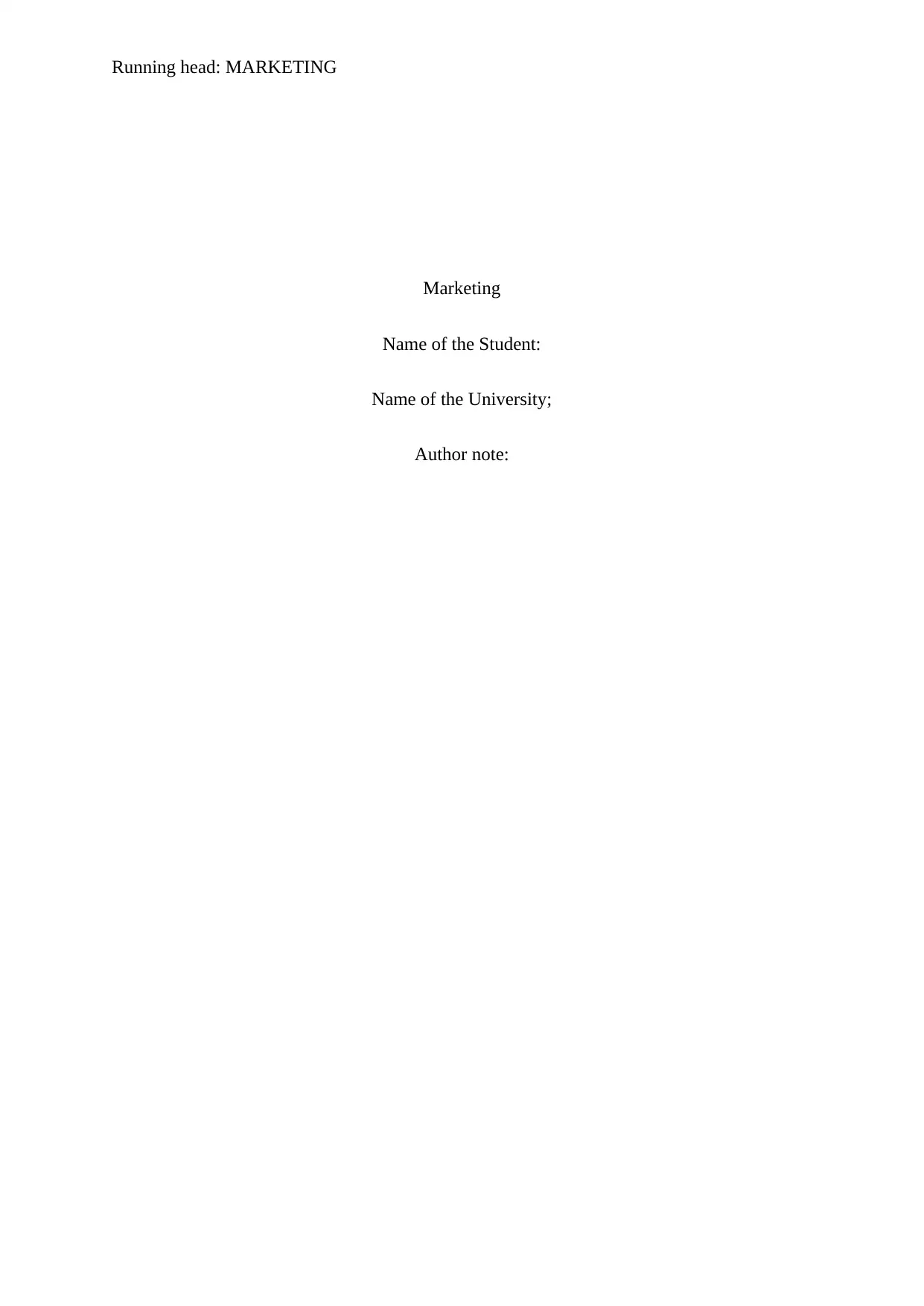
Running head: MARKETING
Marketing
Name of the Student:
Name of the University;
Author note:
Marketing
Name of the Student:
Name of the University;
Author note:
Paraphrase This Document
Need a fresh take? Get an instant paraphrase of this document with our AI Paraphraser
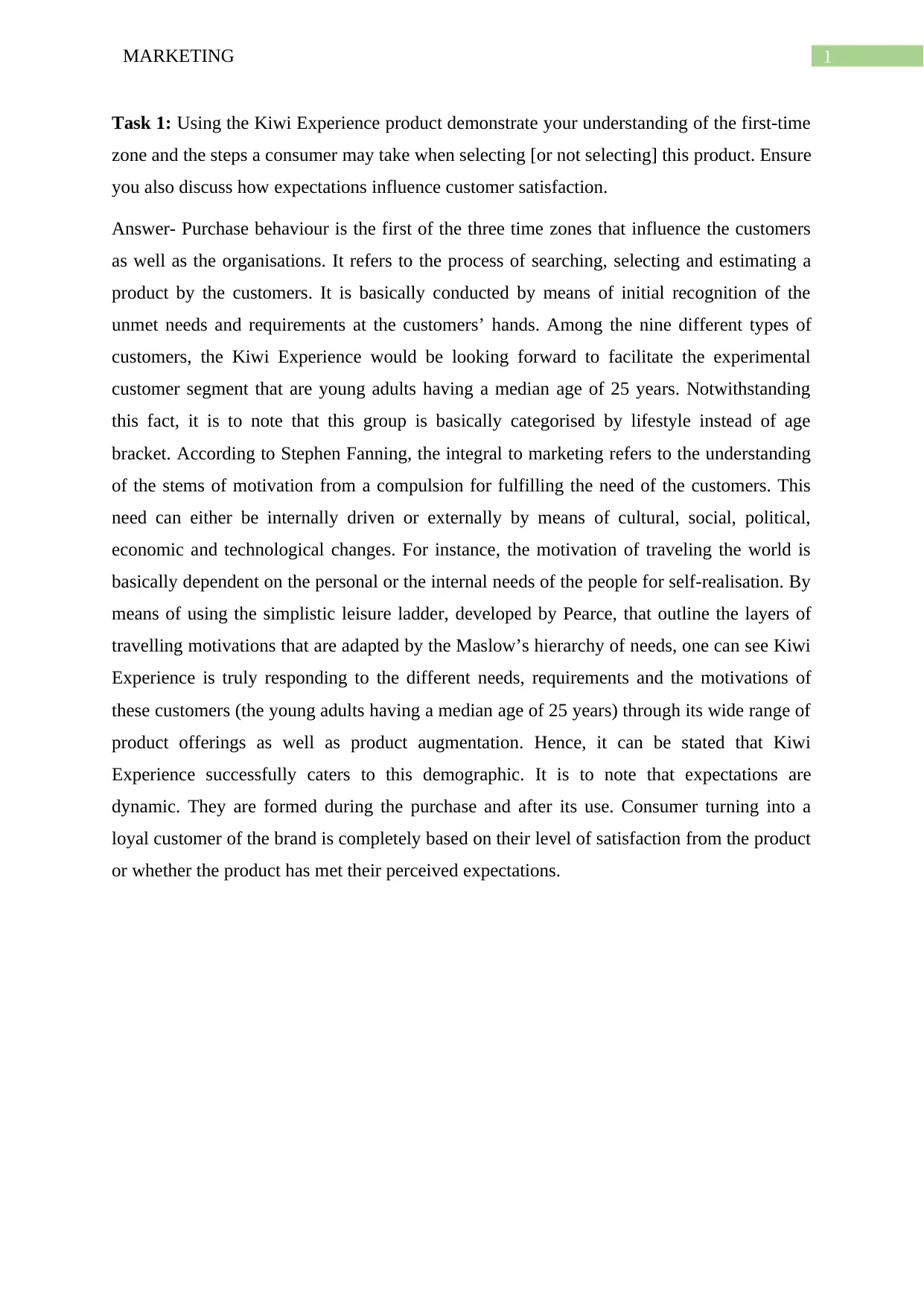
1MARKETING
Task 1: Using the Kiwi Experience product demonstrate your understanding of the first-time
zone and the steps a consumer may take when selecting [or not selecting] this product. Ensure
you also discuss how expectations influence customer satisfaction.
Answer- Purchase behaviour is the first of the three time zones that influence the customers
as well as the organisations. It refers to the process of searching, selecting and estimating a
product by the customers. It is basically conducted by means of initial recognition of the
unmet needs and requirements at the customers’ hands. Among the nine different types of
customers, the Kiwi Experience would be looking forward to facilitate the experimental
customer segment that are young adults having a median age of 25 years. Notwithstanding
this fact, it is to note that this group is basically categorised by lifestyle instead of age
bracket. According to Stephen Fanning, the integral to marketing refers to the understanding
of the stems of motivation from a compulsion for fulfilling the need of the customers. This
need can either be internally driven or externally by means of cultural, social, political,
economic and technological changes. For instance, the motivation of traveling the world is
basically dependent on the personal or the internal needs of the people for self-realisation. By
means of using the simplistic leisure ladder, developed by Pearce, that outline the layers of
travelling motivations that are adapted by the Maslow’s hierarchy of needs, one can see Kiwi
Experience is truly responding to the different needs, requirements and the motivations of
these customers (the young adults having a median age of 25 years) through its wide range of
product offerings as well as product augmentation. Hence, it can be stated that Kiwi
Experience successfully caters to this demographic. It is to note that expectations are
dynamic. They are formed during the purchase and after its use. Consumer turning into a
loyal customer of the brand is completely based on their level of satisfaction from the product
or whether the product has met their perceived expectations.
Task 1: Using the Kiwi Experience product demonstrate your understanding of the first-time
zone and the steps a consumer may take when selecting [or not selecting] this product. Ensure
you also discuss how expectations influence customer satisfaction.
Answer- Purchase behaviour is the first of the three time zones that influence the customers
as well as the organisations. It refers to the process of searching, selecting and estimating a
product by the customers. It is basically conducted by means of initial recognition of the
unmet needs and requirements at the customers’ hands. Among the nine different types of
customers, the Kiwi Experience would be looking forward to facilitate the experimental
customer segment that are young adults having a median age of 25 years. Notwithstanding
this fact, it is to note that this group is basically categorised by lifestyle instead of age
bracket. According to Stephen Fanning, the integral to marketing refers to the understanding
of the stems of motivation from a compulsion for fulfilling the need of the customers. This
need can either be internally driven or externally by means of cultural, social, political,
economic and technological changes. For instance, the motivation of traveling the world is
basically dependent on the personal or the internal needs of the people for self-realisation. By
means of using the simplistic leisure ladder, developed by Pearce, that outline the layers of
travelling motivations that are adapted by the Maslow’s hierarchy of needs, one can see Kiwi
Experience is truly responding to the different needs, requirements and the motivations of
these customers (the young adults having a median age of 25 years) through its wide range of
product offerings as well as product augmentation. Hence, it can be stated that Kiwi
Experience successfully caters to this demographic. It is to note that expectations are
dynamic. They are formed during the purchase and after its use. Consumer turning into a
loyal customer of the brand is completely based on their level of satisfaction from the product
or whether the product has met their perceived expectations.
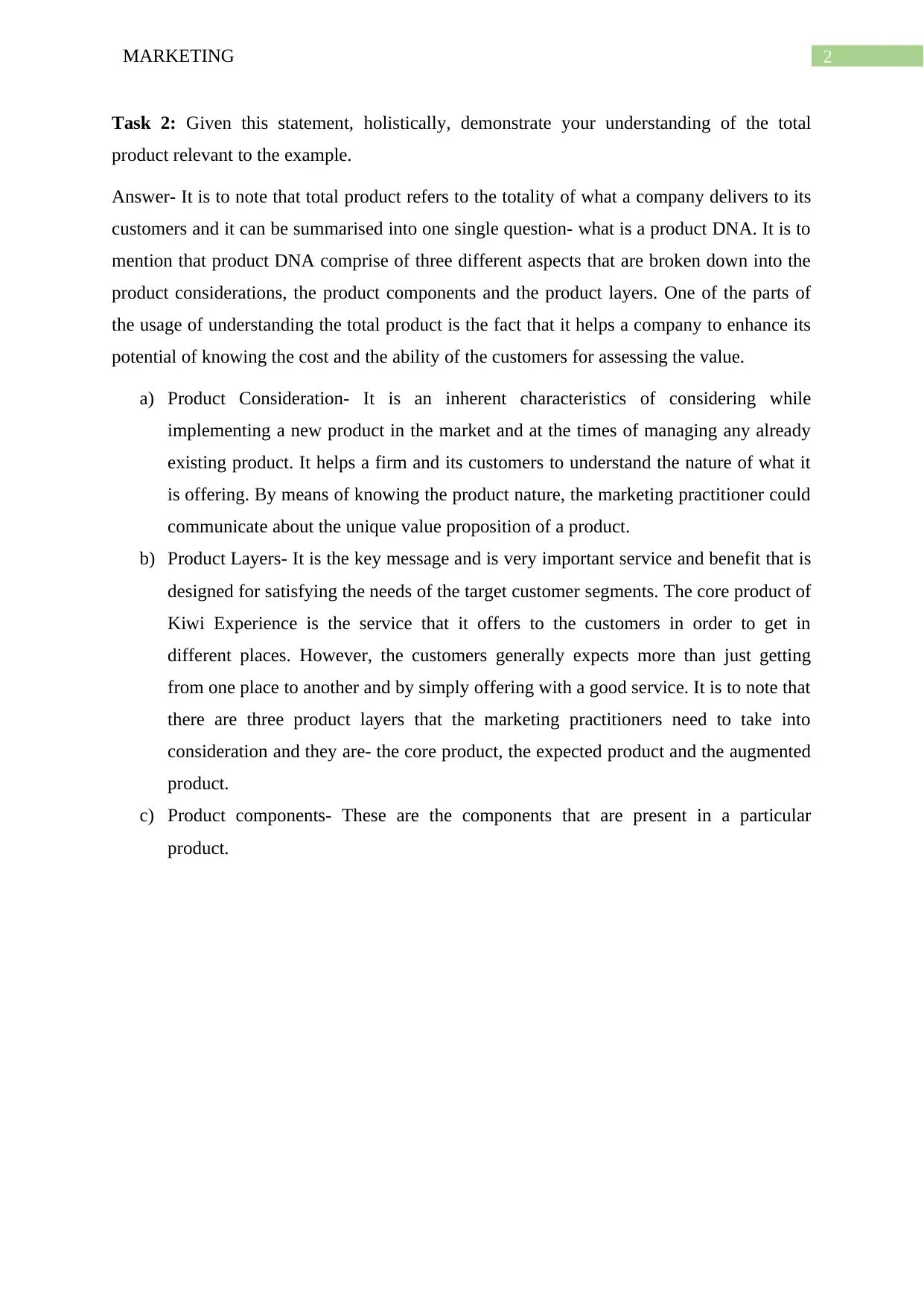
2MARKETING
Task 2: Given this statement, holistically, demonstrate your understanding of the total
product relevant to the example.
Answer- It is to note that total product refers to the totality of what a company delivers to its
customers and it can be summarised into one single question- what is a product DNA. It is to
mention that product DNA comprise of three different aspects that are broken down into the
product considerations, the product components and the product layers. One of the parts of
the usage of understanding the total product is the fact that it helps a company to enhance its
potential of knowing the cost and the ability of the customers for assessing the value.
a) Product Consideration- It is an inherent characteristics of considering while
implementing a new product in the market and at the times of managing any already
existing product. It helps a firm and its customers to understand the nature of what it
is offering. By means of knowing the product nature, the marketing practitioner could
communicate about the unique value proposition of a product.
b) Product Layers- It is the key message and is very important service and benefit that is
designed for satisfying the needs of the target customer segments. The core product of
Kiwi Experience is the service that it offers to the customers in order to get in
different places. However, the customers generally expects more than just getting
from one place to another and by simply offering with a good service. It is to note that
there are three product layers that the marketing practitioners need to take into
consideration and they are- the core product, the expected product and the augmented
product.
c) Product components- These are the components that are present in a particular
product.
Task 2: Given this statement, holistically, demonstrate your understanding of the total
product relevant to the example.
Answer- It is to note that total product refers to the totality of what a company delivers to its
customers and it can be summarised into one single question- what is a product DNA. It is to
mention that product DNA comprise of three different aspects that are broken down into the
product considerations, the product components and the product layers. One of the parts of
the usage of understanding the total product is the fact that it helps a company to enhance its
potential of knowing the cost and the ability of the customers for assessing the value.
a) Product Consideration- It is an inherent characteristics of considering while
implementing a new product in the market and at the times of managing any already
existing product. It helps a firm and its customers to understand the nature of what it
is offering. By means of knowing the product nature, the marketing practitioner could
communicate about the unique value proposition of a product.
b) Product Layers- It is the key message and is very important service and benefit that is
designed for satisfying the needs of the target customer segments. The core product of
Kiwi Experience is the service that it offers to the customers in order to get in
different places. However, the customers generally expects more than just getting
from one place to another and by simply offering with a good service. It is to note that
there are three product layers that the marketing practitioners need to take into
consideration and they are- the core product, the expected product and the augmented
product.
c) Product components- These are the components that are present in a particular
product.
⊘ This is a preview!⊘
Do you want full access?
Subscribe today to unlock all pages.

Trusted by 1+ million students worldwide
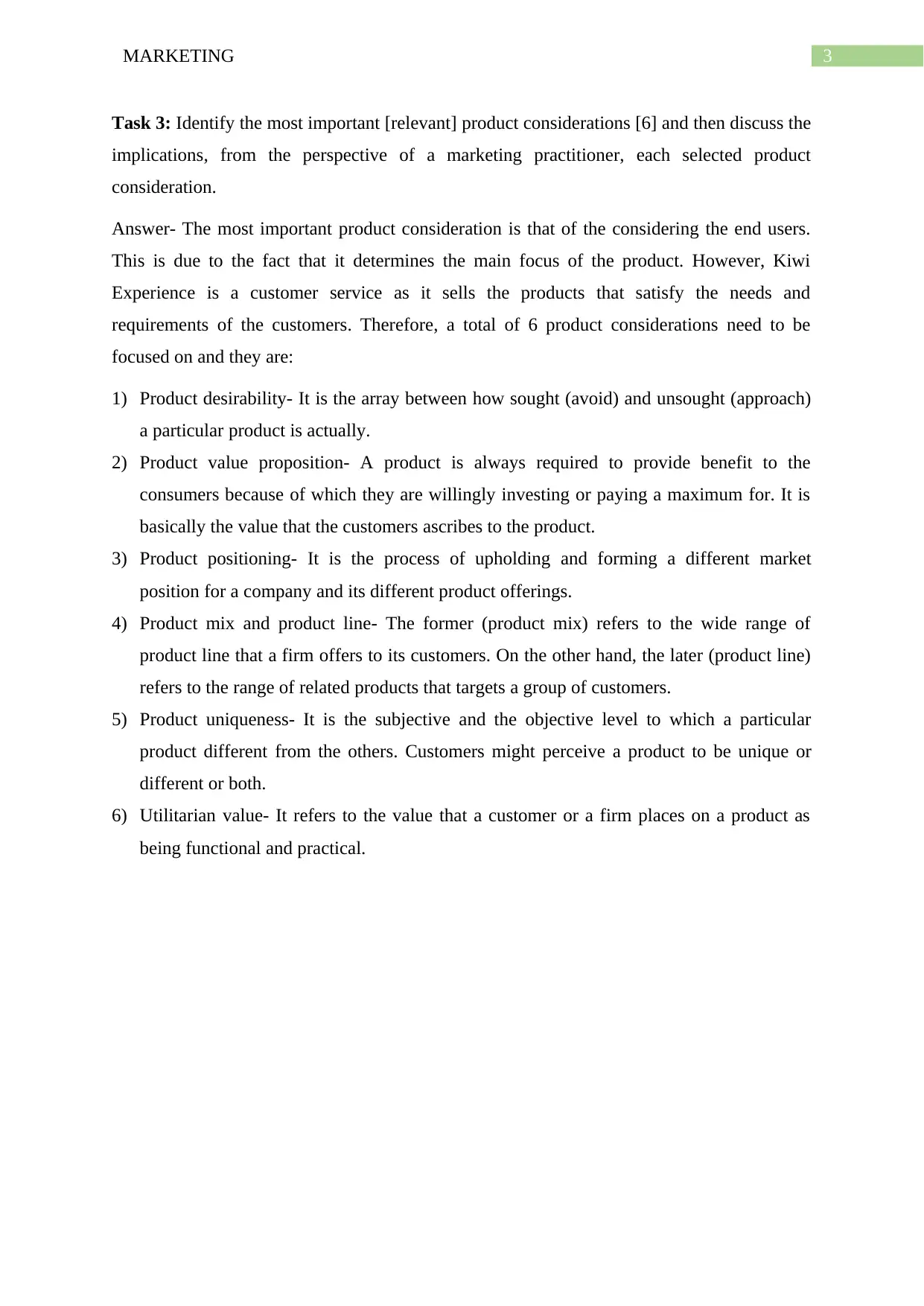
3MARKETING
Task 3: Identify the most important [relevant] product considerations [6] and then discuss the
implications, from the perspective of a marketing practitioner, each selected product
consideration.
Answer- The most important product consideration is that of the considering the end users.
This is due to the fact that it determines the main focus of the product. However, Kiwi
Experience is a customer service as it sells the products that satisfy the needs and
requirements of the customers. Therefore, a total of 6 product considerations need to be
focused on and they are:
1) Product desirability- It is the array between how sought (avoid) and unsought (approach)
a particular product is actually.
2) Product value proposition- A product is always required to provide benefit to the
consumers because of which they are willingly investing or paying a maximum for. It is
basically the value that the customers ascribes to the product.
3) Product positioning- It is the process of upholding and forming a different market
position for a company and its different product offerings.
4) Product mix and product line- The former (product mix) refers to the wide range of
product line that a firm offers to its customers. On the other hand, the later (product line)
refers to the range of related products that targets a group of customers.
5) Product uniqueness- It is the subjective and the objective level to which a particular
product different from the others. Customers might perceive a product to be unique or
different or both.
6) Utilitarian value- It refers to the value that a customer or a firm places on a product as
being functional and practical.
Task 3: Identify the most important [relevant] product considerations [6] and then discuss the
implications, from the perspective of a marketing practitioner, each selected product
consideration.
Answer- The most important product consideration is that of the considering the end users.
This is due to the fact that it determines the main focus of the product. However, Kiwi
Experience is a customer service as it sells the products that satisfy the needs and
requirements of the customers. Therefore, a total of 6 product considerations need to be
focused on and they are:
1) Product desirability- It is the array between how sought (avoid) and unsought (approach)
a particular product is actually.
2) Product value proposition- A product is always required to provide benefit to the
consumers because of which they are willingly investing or paying a maximum for. It is
basically the value that the customers ascribes to the product.
3) Product positioning- It is the process of upholding and forming a different market
position for a company and its different product offerings.
4) Product mix and product line- The former (product mix) refers to the wide range of
product line that a firm offers to its customers. On the other hand, the later (product line)
refers to the range of related products that targets a group of customers.
5) Product uniqueness- It is the subjective and the objective level to which a particular
product different from the others. Customers might perceive a product to be unique or
different or both.
6) Utilitarian value- It refers to the value that a customer or a firm places on a product as
being functional and practical.
Paraphrase This Document
Need a fresh take? Get an instant paraphrase of this document with our AI Paraphraser
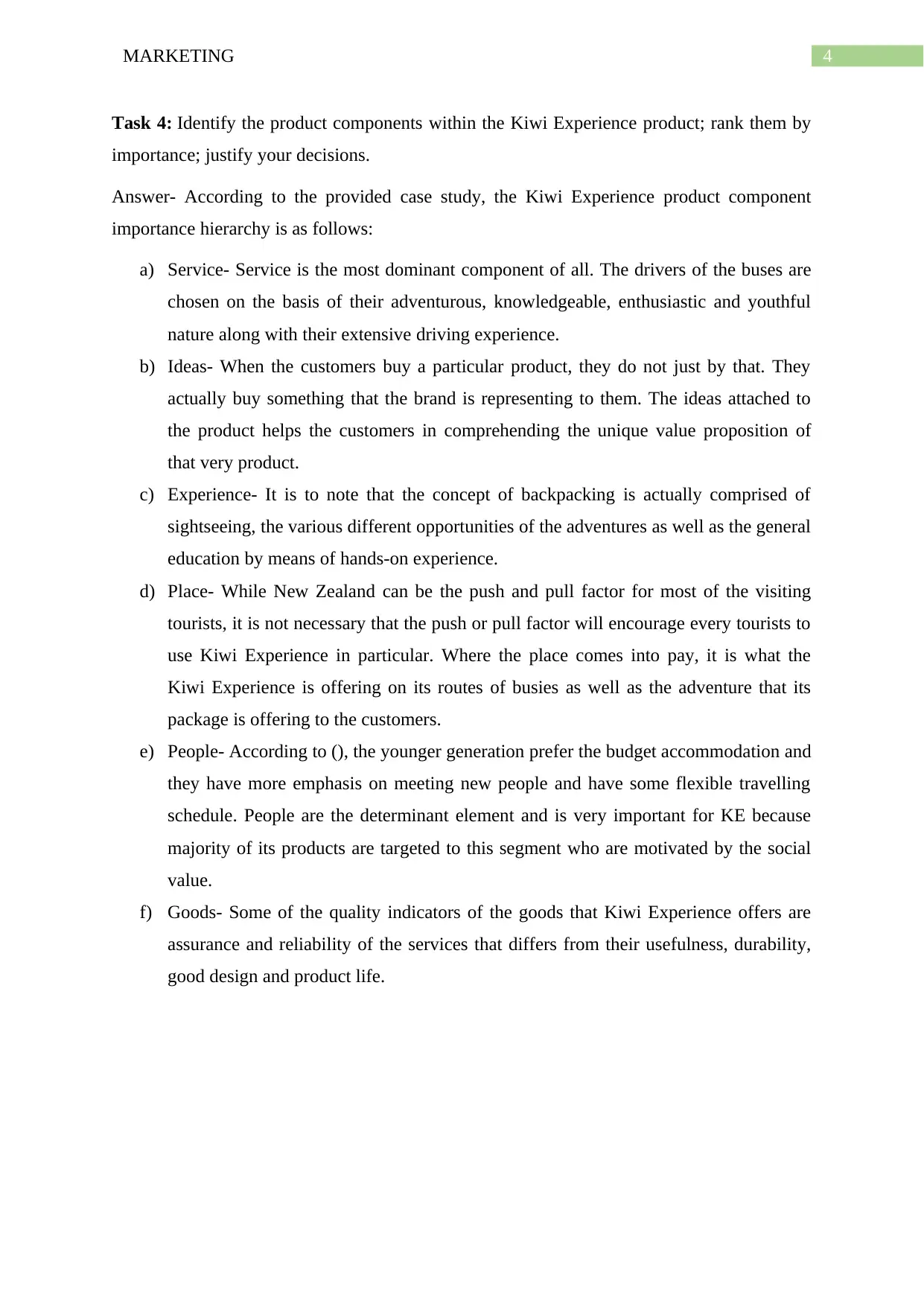
4MARKETING
Task 4: Identify the product components within the Kiwi Experience product; rank them by
importance; justify your decisions.
Answer- According to the provided case study, the Kiwi Experience product component
importance hierarchy is as follows:
a) Service- Service is the most dominant component of all. The drivers of the buses are
chosen on the basis of their adventurous, knowledgeable, enthusiastic and youthful
nature along with their extensive driving experience.
b) Ideas- When the customers buy a particular product, they do not just by that. They
actually buy something that the brand is representing to them. The ideas attached to
the product helps the customers in comprehending the unique value proposition of
that very product.
c) Experience- It is to note that the concept of backpacking is actually comprised of
sightseeing, the various different opportunities of the adventures as well as the general
education by means of hands-on experience.
d) Place- While New Zealand can be the push and pull factor for most of the visiting
tourists, it is not necessary that the push or pull factor will encourage every tourists to
use Kiwi Experience in particular. Where the place comes into pay, it is what the
Kiwi Experience is offering on its routes of busies as well as the adventure that its
package is offering to the customers.
e) People- According to (), the younger generation prefer the budget accommodation and
they have more emphasis on meeting new people and have some flexible travelling
schedule. People are the determinant element and is very important for KE because
majority of its products are targeted to this segment who are motivated by the social
value.
f) Goods- Some of the quality indicators of the goods that Kiwi Experience offers are
assurance and reliability of the services that differs from their usefulness, durability,
good design and product life.
Task 4: Identify the product components within the Kiwi Experience product; rank them by
importance; justify your decisions.
Answer- According to the provided case study, the Kiwi Experience product component
importance hierarchy is as follows:
a) Service- Service is the most dominant component of all. The drivers of the buses are
chosen on the basis of their adventurous, knowledgeable, enthusiastic and youthful
nature along with their extensive driving experience.
b) Ideas- When the customers buy a particular product, they do not just by that. They
actually buy something that the brand is representing to them. The ideas attached to
the product helps the customers in comprehending the unique value proposition of
that very product.
c) Experience- It is to note that the concept of backpacking is actually comprised of
sightseeing, the various different opportunities of the adventures as well as the general
education by means of hands-on experience.
d) Place- While New Zealand can be the push and pull factor for most of the visiting
tourists, it is not necessary that the push or pull factor will encourage every tourists to
use Kiwi Experience in particular. Where the place comes into pay, it is what the
Kiwi Experience is offering on its routes of busies as well as the adventure that its
package is offering to the customers.
e) People- According to (), the younger generation prefer the budget accommodation and
they have more emphasis on meeting new people and have some flexible travelling
schedule. People are the determinant element and is very important for KE because
majority of its products are targeted to this segment who are motivated by the social
value.
f) Goods- Some of the quality indicators of the goods that Kiwi Experience offers are
assurance and reliability of the services that differs from their usefulness, durability,
good design and product life.
1 out of 5
Related Documents
Your All-in-One AI-Powered Toolkit for Academic Success.
+13062052269
info@desklib.com
Available 24*7 on WhatsApp / Email
![[object Object]](/_next/static/media/star-bottom.7253800d.svg)
Unlock your academic potential
© 2024 | Zucol Services PVT LTD | All rights reserved.





